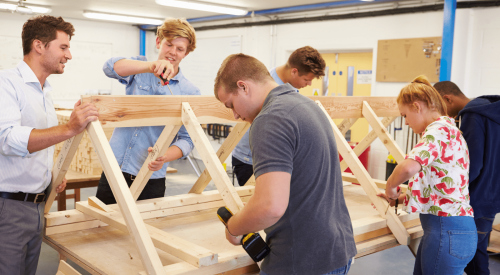Home building’s labor shortage is not abating. According to NAHB figures, in the beginning of this year there were 250,000 more construction jobs available than there were workers to fill them. The overall unemployment rate for the construction industry—a number that reflects unfilled positions—stood at 7.4 percent in March, while the national unemployment rate was just 4.1 percent.
Of those open positions, the most difficult to fill are those of the skilled trades. The industry lost 1.5 million workers during the recession, and the trades, including carpenters, bricklayers, welders, electricians, plumbers, and others, were hit pretty hard. The category still hasn’t rebounded, and possesses the unhappy distinction of being No. 1 in all job vacancies from 2010 to the present.
These jobs, many of which used to be held by immigrants, may very well remain unfilled unless the industry makes some serious changes in how it attracts and retains new employees. Across the country, construction training programs have been effective in calling attention to construction as a career. But the number of workers trained hasn’t yet made a dent in the overall employee shortfall, and may not unless some underlying changes are made in the structure of the jobs themselves and their benefits.
It may be instructive to look at what others are doing in this regard. For example, Japan’s workforce has been declining for years. Its population decreased by 300,000 just this past year and is aging faster than most countries (more than a quarter of its citizens are over the age of 65). With no immigrants to fill open jobs, prime minister Shinzo Abe instead focused on the most underutilized portion of the populace: women. Traditionally, women in Japan were either full-time homemakers or career women without families. When Abe took office in 2012, more than 50 percent of Japanese women were working outside of the home, but mostly in part-time, low-skilled, and low-paying jobs. In addition, the number of women who returned to work after having children was just 38 percent.
Abe’s program, dubbed Womenomics, set goals for increasing the overall participation of women in the workforce as well as tripling the number of women in management roles. Focusing on the factors that keep many women from working full time, the Japanese government allocated funds for 400,000 spaces in daycare centers. Recently, Abe has said he will try to pass legislation for free daycare and preschool for children age 5 and under. Japanese companies also have begun offering paid family leave.
Critics of the program have pointed out that the goal of promoting women to management roles hasn’t met with success and that the availability of daycare does not yet come close to meeting the need. But the number of working women in Japan has increased by more than one percentage point each year since 2013. On a percentage basis, the number of women in Japan’s job market now exceeds that of the U.S. Surprisingly, one of the industries that has made the greatest strides in employing women is construction. Japanese women now make up 15 percent of the construction labor force, while the U.S. number hovers around 9 percent.
In a recent article for MarketWatch, Rob Dietz, NAHB’s chief economist, put the number of construction workers needed in the U.S. right now at 200,000. Long term, reaching a “sustainable level of production” would call for another half a million workers. An increase like this can’t be accomplished without making some major changes. A good place to start would be for companies to try offering options such as flexible work schedules, paid family leave, and child care subsidies. These benefits would provide assistance to both men and women and open up the field to a much greater number of potential candidates. Doing so would add to costs, for sure, but it also might keep many companies in business.













